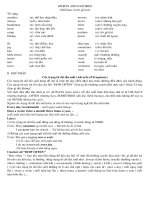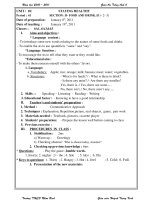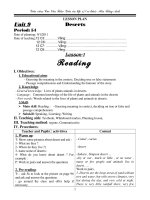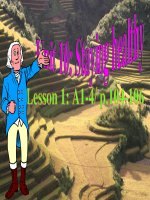Tài liệu TA 12 Unit 10 (C.Tien.TQ)
Bạn đang xem bản rút gọn của tài liệu. Xem và tải ngay bản đầy đủ của tài liệu tại đây (230.39 KB, 12 trang )
Gi¸o viªn: Cao V¨n TiÕn- Gi¸o ¸n líp 12 (c¬ b¶n)- M«n TiÕng Anh
Lesson plan
Unit 10
Endangered Species
Date of planning:
Date of teaching:12 C1:……………………………………………………………
12 C2:……………………………………………………………
12 C4:……………………………………………………………
12 C6:…………………………………………………………..
Lesson:60
Reading
I. Oblectives:
1. Educational aims:
- Students read and guess the meaning of words in contexts.
- They read and answer questions about the texts.
- They practice scanning for specific information in the texts.
- Finding supporting evidence.
2. Knowledge:
- General knowledge: Ss know some endangered species are plant and animal
species.
- Language: Common knowledge of environment,…
- New words: Words related to the topic (endangered animals,plants....)
3.Skill:
Main skill: Reading
Subskill: Speaking, Listening, Writing
II. Teaching aids: Textbook, Whiteboard markes, Planning lesson,
III. Teaching method: regrate, Communicative
IV. Procedures:
Teacher and Pupils’ activitives Content
1. Warm up:
T. asks sts to sort out animals by completing
the poster with words provided.
P: work in pairs and answer the questions
T. gives feedback and comments
- T. focuses sts on the topic: Endangered
animals
2. Pre-reading:
T: - ask Ss look at the picture on page 106
and answer the questions.
Pets Endangered animals
Dogs Pandas
*Words:
- tigers, monkeys, dogs, pandas, cats, chicken,
elephants ...
Suggested answers:
1. monkey, elephant, mosquito……
2. Tortoise and rhinoceros are in danger of
1
Giáo viên: Cao Văn Tiến- Giáo án lớp 12 (cơ bản)- Môn Tiếng Anh
P: look at the picture on page 106 and answer
the questions.
- work in pairs.
T:- read word by word.
P: repeat after the teacher in chorus and
individual and write down
T:- ask Ss to repeat in chorus and individual
and write them on the blackboard.
3. While-reading:
T: - ask Ss to read the passage in silence and
do task 1.
P: read the passage in silence and do task 1.
T:- ask Ss to compare the answer with a
partner.
T:- call on some Ss to answer in front of the
class.
P: - compare the answer with a partner.
- some Ss answer in front of the class
- comment and give correct answer.
- ask Ss to read the passage again and choose
A, B, C, D to complete the following
sentences about the reading passage.
4. Post-reading:
P: - ask Ss to work in groups to discuss the
questions.
- go around the class to give help if
necessary.
becoming extinct because they are hunted for
food and medicine. The hard round shells of
the tortoise are used to make
handicrafts.Rhinos horns are a kind of
previous medicine.
I. Vocabulary:
- habitat (n) ['hổbitổt] : môi trờng sống
- deforestation (n) [di,fris'tein] : sự phá
rừng
- urbanization (n) [,:bnai'zein] : sự đô thị
hoá
- biodiversity (n) [,baioui'kldist] : bầu
sinh quyển
- priority (n) [prai'rti] : sự u tiên, quyền u
tiên
- vulnerable (adj) ['vlnrbl] : yếu ớt, dễ bị
tổn thơng
- enact (v) [i'nổkt] : ban hành
I. Task 1: The nouns in column A all appear
in the passage.
Answers:
1. C
2. D
3. A
4. B
II. Task 2: Choose A, B, C or D to complete
the following sentences.
Answers:
1. D
2. B
3. A
4. A
5. D
III. Task 3: Answer the question.
Answers:
1. The first sentence of the second passage.
2. The third passage.
3. The fourth passage.
Questions:
1. What are the main causes of extinction
or endangerment?
2. How important is biodiversity for
humans?
3. What should we do to conserve
2
Gi¸o viªn: Cao V¨n TiÕn- Gi¸o ¸n líp 12 (c¬ b¶n)- M«n TiÕng Anh
- give suggested words, phrases or useful
suggestions.
- correct the Ss’ work
P: - work in groups to discuss the questions.
endangered species?
Suggested answers:
1. The main causes of extinction or
endangerment are habitat destruction,
commercial exploitation and pollution.
2. Biodiversity is important6 for humans as it
provides food, clear air, water fertile soil and
other products.
3. To conserve endangered species, wild
animals habitat mustn t be destroyed. We’ ’
should raise our awareness of conservations
needs. Laws should be enacted to protect
wildlife from commercial trade and
overhunting.
5. Home work: - Summarize the main points.
- Assign homework.
- Prepare new lesson.
6. Comment: ……………………………………………………………………………….
……………………………………………………………………………….
……………………………………………………………………………….
Lesson plan
Unit 10
Endangered Species
Date of planning:
Date of teaching12 C1:……………………………………………………………
12 C2:……………………………………………………………
12 C4:……………………………………………………………
12 C6:…………………………………………………………..
Lesson:61
Speaking
I. Oblectives:
1. Educational aims:
- Students work in pairs to ask and answer some questions about endangered animals
- Students talk about the information of some endangered animals
2. Knowledge:
- General knowledge: endangered animals
- Language: + The way to make suggestions or predictions.
+ The tenses.
- New words: words related to endangered species.
3.Skill:
3
Gi¸o viªn: Cao V¨n TiÕn- Gi¸o ¸n líp 12 (c¬ b¶n)- M«n TiÕng Anh
Main skill: Speaking: - Talking about the information of some endangered animals
Subskill: Reading, Listening, Writing
II. Teaching aids: Textbook, Whiteboard markes, Planning lesson,
III. Teaching method: regrate, Communicative
IV. Procedures:
Teacher and Pupils’ activitives Content
1. Warm up:
T: Look at the pictures of 4 animals and give
their names:
P: look at the pictures and call out the names
of the animals.
T: go around the class and offers help if
necessary.
- call on some Ss to give their answers
2. Pre-speaking:
T- ask Ss to work in pairs to discus the four
questions and find the answers.
P: work in pairs to discus the four questions
and find the answers
T:- move round to make sure that all Ss are
working and to help them if necessary.
P: some Ss report.
3. While-speaking:
T: - elicit questions can be used to ask about
endangered species.
- go around the class and offer help if
necessary.
- call on some Ss to answer in front of the
class.
- comment and give suggested answers.
T: Ask and answer questions about 4
endangered animals.
Suggested answers:
1. It is a tiger
2. It is a rhino
3. It is a panda
4. It is an elephant
Task 1: Ask and answer the following the
questions.
Answers:
1. We call these animals: Panda, rhino,
tiger and elephant.
2. We can find these animals in the forests
in Asia, Africa,……
( Pandas can be seen in bamboo forests.
Rhino ca be found in grasslands and swamps,
and elephants can be seen in forests.)
3. Rhino can be used for medicine ( None
of these animals can be kept an a pet, except
for tiger can be used for food and medicine.)
4. All of them are in danger.
Useful questions:
- Habitat: Where do…………live?
- Population: What is the population
of………?
- Height: How tall are they?
- Weight: How much do they weigh?
- Food: What do they eat? / What is their
main food?
- Life span: How long do they live? / What is
the life span of……….?
- Reason for decline: Why are they in
danger? / What are the reasons for their
decreasing in number?
Task 2:
FEED BACK 2:
4
Gi¸o viªn: Cao V¨n TiÕn- Gi¸o ¸n líp 12 (c¬ b¶n)- M«n TiÕng Anh
T: Asks Ss to read the information about the
giant panda, tiger, rhino, elephant.
- Explain how to do task 2
P: read throught information one times
T:- Walk round from group to group to give
help if necessary.
- Encourage students to speak out what they
think even a phrase or a singular word.
- T check and give feedback.
P: work in pairs
4. Post-speaking:
-T: asks Ss to work in group to do task 2.
P: work ion groups
T:Walk round from group to group to give
help if necessary.
- Encourage students to speak out what they
think.
- Invite some groups’ representatives to
report their ideas.
- Give feed back and make comments.
- work in pairs to do task 2
A: where do giant pandas live?
B: They live in bamboo forests in the
mountain in central and western China
A: What is the population of pandas in the
world?
B: Only about 600.
A: How tall are they?
B: about 1.2 to 1.5m
A How much do they weigh?
B: About 75 kg to 160 kg
A: what do they eat/What is their main food?
B: Bamboo
A: How long do they live?
B: About 20 to 30 years
A: Why are they in danger?
B: People destroy their habitat and hunt them
for trade
Task 3 Take turns to give an oral report on
the animals mentioned in task 2
FEED BACK 3:
- Work in group to give an oral report.
Example
Group 1: Giant pandas live in bamboo
forests in the mountain in Western China
.only about 600 pandas are living there. They
attain a height of 1.2m to 1.5m and weigh
from 75kg to 160 kg. Giant pandas can live
up to 20 or 30 years. they are in danger
because People are destroying their habitat
and hunt them for trade.
Group 2: Rhino
Group 3: Tiger
Group 4: Elephant
5. Home work: - Summarize the main points.
- Assign homework.
- Prepare new lesson.
6. Comment: ……………………………………………………………………………….
……………………………………………………………………………….
……………………………………………………………………………….
Lesson plan
5









